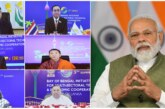India is faced with an acute energy crisis that is adversely impacting its economic growth. At stake is India’s ability to bring electricity to 400 million rural residents—a third of the population as well as provide enough fuel for 1.5 million new vehicles added to the roads each month. According to energy experts, shortages of coal, oil and natural gas will require India to import increasing amounts of high-cost fossil fuels, risking inflation and putting the country in stepped-up competition with China, Japan and South Korea.
India’s energy demand is expected to more than double in the next two decades to the equivalent of six billion barrels of oil, the energy crunch threatens to knock India off its growth path. Expensive imports have taken a toll on the nation’s finances. Though global crude oil prices have eased in the past few months, India is seeing little benefit because its currency, the rupee, has been dropping against the dollar, the currency used to price oil.
According to some economists, it is being realized that there’s a very bleak outlook in terms of energy security, and that this is going to create the single largest constraint on the economy, one of alarming proportions.
A shortage of coal, which accounts for more than half of the nation’s energy supply, is crippling the power sector, forcing companies to delay the opening of multibillion-dollar projects. In April this year, India announced an 80% jump in coal imports for the fiscal year ended in March, to $17.6 billion. But many plants still run below capacity for lack of coal.
The government had looked to natural gas. But a production shortfall at the nation’s largest known gas field—operated by Reliance Industries —has India racing to increase gas imports.
India now imports three-quarters of its oil, and the price tag has been growing. The import bill was $141 billion in the past fiscal year, a 41% jump over a year earlier. As global oil prices have declined, India’s crude oil import costs have decreased about 15% in dollar terms since January. But the rupee has depreciated 12% over that time, canceling out the gain.
Domestic oil fields are maturing, production is barely increasing and companies complain regulations are stifling.
Plans to boost nuclear energy production faltered after the Indian Parliament passed a law that foreign equipment suppliers say would burden them with liability after accidents, rather than plant operators, which is the international standard. Environmental protests after the Fukushima disaster in Japan last year also have delayed the opening of new nuclear plants.
Some economists feel that energy imports will be costly for India’s already shaky public finances and the government will have to pass on higher costs to consumers and businesses. That won’t be easy.
Natural gas—which is used in public transportation, cooking fuel and the making of fertilizer—has its own troubles. India was banking on a $5.6 billion project in the Bay of Bengal off India’s east coast. Reliance Industries discovered the gas in late 2002, an apparent energy bonanza. Output was projected to reach 2.8 billion cubic feet per day in the fiscal year that began on 1 April this year. However, the company officials feel that output is now about 1.05 billion cubic feet per day and could fall to 600 million units in the next two years.
This leaves ample scope for augmenting capacity of hydropower, wind power generation and renewable sources of energy to meet the growing energy demand. However, the country’s installed power generation capacity had increased from just 1.4 GW in 1947 to over 150 GW in 2009. The current generation mix in India is dominated by coal (78.5 GW), large hydropower (36.9 GW) and gas (16.4 GW). Renewable sources rank fourth with an installed capacity of around 13.2 GW.
In the early 1980s, the Indian government established the Ministry of Non-Conventional Energy Sources (MNES) to encourage diversification of the country’s energy supply to meet the increasing energy demand of a rapidly growing economy. In 2006, this ministry was renamed the Ministry of New and Renewable Energy (MNRE).
Renewable energy is growing rapidly in India. With an installed capacity of 13.2 GW, renewable energy sources (excluding large hydro) currently account for 9% of India’s overall power generation capacity. By the close of current year, the government is contemplating to add an extra 14 GW of renewable sources.
In its 10th Five Year Plan, the Indian government had set itself a target of adding 3.5 GW of renewable energy sources to the generation mix. In reality, however, nearly double that figure was achieved. In this period, more than 5.4 GW of wind energy was added to the generation mix, as well as 1.3 GW from other REsources. The target set for the period from 2008-2012 was increased to 14 GW, 10.5 GW of which to be new wind generation capacity.
The Ministry of New and Renewable Energy (MNRE) estimates that there is a potential of around 90,000 MW for power generation from different renewable energy sources in the country, including 48,561 MW of wind power, 14,294 MW of small hydro power and 26,367 MW of biomass. In addition, the potential for solar energy is estimated for most parts of the country at around 20 MW per square kilometer of open, shadow free area covered with solar collectors, which would add up to a minimum of 657 GW of installed capacity.
Wind potential
The total potential for wind power in India was first estimated by the Centre for Wind Energy Technology (C-WET) at around 45 GW, and was recently increased to 48.5 GW. This figure was also adopted by the government as the official estimate. The C-WETstudy was based on a comprehensive wind mapping exercise initiated by MNRE, which established a country-wide network of 1050 wind monitoring and wind mapping stations in 25 Indian States. This effort made it possible to assess the national wind potential and identify suitable areas for harnessing wind power for commercial use, and 216 suitable sites have been identified.
However, the wind measurements were carried out at lower hub heights and did not take into account technological innovation and improvements and repowering of old turbines to replace them with bigger ones. At heights of 55-65 meters, the Indian Wind Turbine Manufacturers Association (IWTMA) estimates that the potential for wind development in India is around 65-70 GW. The World Institute for Sustainable Energy, India (WISE) considers that with larger turbines, greater land availability and expanded resource exploration, the potential could be as big as 100 GW.
Electricity demand has continuously outstripped production, and a peak energy shortage of around 12.7% prevailed in 2009. To meet this shortfall as well as the National Electricity Policy target of ‘Electricity for All by 2012’, the cleanest options available to India are Renewable Energy Technologies (RETs). For the government to seriously consider meeting its promise of electricity for all by 2012, renewable energy options including wind power are prone to play a crucial role in India’s emerging energy mix. Not only are they environmentally sound but also their project gestation periods are significantly shorter than those for thermal or nuclear power plants.
According to the Ministry of New and Renewable Energy (MNRE), presently the share of renewable based capacity is 10.9% (excluding large hydro) of the total installed capacity of 170 GW in the country, up from 2% at the start of the 10th Plan Period (2002-2007). This includes 13,065.78 MW of wind, 2,939 MW of small hydro power, 1,562 MW of (bagasse based) cogeneration, 997 MW of biomass, 73.46 MW of ‘waste to power’ and 17.80 MW of solar PV for grid connected renewables at the end of 20107.
The originally stated cumulative target for the current plan period was to add 92 GW8 of new capacity of which about 14 GW was to come from renewable sources. Given the right mix of regulatory and institutional support, renewable sources could meet the proposed capacity addition of 14 GW from renewable energy before the end of the 11th five year plan-period (2007-2012). This would bring the total share of renewable energy sources upto 15% of the new installed capacity in the 11th plan-period.
Over the next decade, India will have to invest in options that not only provide energy security but also provide costeffective tools for eradicating energy poverty across the board. India is a signatory to the United Nations Framework Convention on Climate Change (UNFCCC) and has as part of its obligations released a National Action Plan on Climate Change9 (released in June 2008) by Prime Minister Manmohan Singh which has laid out his government’s vision for a sustainable and green future for India’s economy. India’s developmental needs will be challenged by climate change impacts. This requires a timely pre-emptive shift towards achieving an energy efficient and green economy. Over the next couple of decades renewable energy will play a major role in delivering that shift.
Wind Power Scenario
There are several published scenarios that appraise the future role of wind power globally as a part of the necessary energy system overhaul towards a clean energy future. The Global Wind Energy Council (GWEC) developed its scenarios in collaboration with Greenpeace International and the German Aerospace Centre (DLR). These scenarios are updated biennially. The resultant publication – the Global Wind Energy Outlook (GWEO) – first looks toward 2020, and then onwards to 2030 and 2050. Some of the other prominent scenarios are the World Energy Outlook (2010) from the International Energy Agency (IEA) and the Energy [R]evolution. There are many variables that will determine the path of development and growth of wind energy. The box above lists the assumptions underlying the GWEO scenarios and associated assumptions for wind power development.
GWEO Scenario
The GWEO scenarios show that even with the continuation of current policy measures to encourage wind power development and serious government efforts to meet existing targets, the resulting ‘Moderate’ scenario growth will put the development of wind power on a dramatically different trajectory from the IEA-based ‘Reference’ scenario. The global wind markets have grown by an average 28% per year in terms of total installed capacity during the last decade. The IEA’s Reference scenario suggests that growth rates for wind power would decrease substantially in the coming years, and that 2010 would see an addition of only 26.8 GW. However, in reality the global wind industry added 35.8 GW during the year.
The Indian market grew by almost 68% on a year-on-year basis with 2,139 MW of new capacity installed between January and December 2010. This made India the third largest annual market after China and the USA for 2010. With more than 13 GW of total installed capacity at the end of 2010, India ranks fifth in the world in terms of cumulative installed capacity.
The IEA projects that 327 GW of power generation capacity will be needed in India by 2020, which would imply a yearly addition of about 16 GW. This is reflected in the stated target for new capacity addition by the Indian government under its 11th Five Year Plan. The plan envisages an addition of 78.7 GW by 2012 from traditional sources (coal, nuclear and large hydro) and an additional 9 GW by 2012 (revised from 10.5 GW) from new wind generation capacity.
During the first three years of the 11th Plan period ending March 2010, India added 4.6 GW of wind power capacity. With over a year to go before the current plan period is over it is very likely that Indian wind power installations will meet and exceed the 11th plan-period target, which will be a record of sorts as historically the targets have never been met through conventional thermal and hydro projects within a plan period.
Under the IEA’s Reference scenario, India’s wind power market is shown to shrink considerably to only about 600 MW per year by 2030. This translates into a total installed capacity of merely 24 GW by 2020 and 30.5 GW by 2030. Wind power would then produce close to 60 TWh every year by 2020 and 75 TWh by 2030, and save 35 million tons of CO2 in 2020 and 45 million tons in 2030. Investment in wind power in India would drop to about $910 million by 203015 [at 2010 $ value].
However under the GWEO scenarios, it is expect that by the end of 2015, between 24.7 GW and 29 GW will be installed in India. Under the moderate scenario this would reach almost 46 GW by 2020 and 108 GW by 2030. In this scenario, about $9 billion would be invested in Indian wind power development every year by 2020, representing a quadrupling of the 2009 investment figures. Employment in the sector would grow from the currently estimated 28,000 jobs to over 84,000 by 2020 and 113,000 by 2030.
The GWEO advanced scenarios show that wind power development in India could go much further depending upon adequate regulatory support and political will. By 2020 India could have 65 GW of wind power in operation, employing 170,000 people and saving 173 million tons of CO2 emissions each year. Investment by then would be to the tune of $10.4 billion per year. The World Institute for Sustainable Energy (WISE) estimates deploying just the current generation of wind turbines could yield a potential onshore wind power capacity of 65 GW–100 GW.
The Ministry of New and Renewable Energy (MNRE) has so far underplayed the potential of renewable energy (RE) sources in India. With the present level of momentum established in India’s wind sector, the ten years between 2020 and 2030 could see spectacular growth if some of the systemic barriers are addressed in a timely manner. With the political will geared towards fully exploiting the country’s wind resource and reaping the accompanying economic, environmental and energy security benefits, the ‘Advanced scenario’ could be reached, which would see substantial wind power growth in many regions of the country. Wind power would then be instrumental in achieving a genuine energy revolution, putting India on the path to a sustainable energy future. India is now at a crossroads for making these decisions, which will determine the future of its energy system.
Wind turbine installations
Wind turbine generator (WTG) capacity addition in India has taken place at a CAGR19 of 24.67% for the period of 1992-2010. The installed capacity increased from a modest base of 41.3 MW in 1992 to reach 13,065.78 MW by December 2010. The official installation figures show that amongst the states, Tamil Nadu ranks the highest both in terms of installed capacity and in terms of energy generation from wind, with shares of 41.8% and 53.4% respectively. Other states like Gujarat, Maharashtra and Rajasthan have seen significant growth in wind capacity over the last four to five years, also due to a stable policy and regulatory regime. Table below provides an overview of the share of different states in installed capacity (MW) and cumulative energy generation (in Million Units20).
Table State-wise generation and installed capacity
| State | Cumulative
Generation(MU) |
Cumulative Installed
Capacity (MW) |
| Andhra Pradesh | 1,451 | 138.4 |
| Gujarat | 8,016 | 1,934.6 |
| Karnataka | 9,991 | 1,517.2 |
| Madhya Pradesh | 554 | 230.8 |
| Maharashtra | 11,790 | 2,108.1 |
| Rajasthan | 3,938 | 1,095.6 |
| Tamil Nadu | 41,100 | 5,073.1 |
| Kerala | 110 | 28 |
| Total | 76,950 | 12,125.8 |
The figures are up to 31st March 2010. Source: WISE, January 2011
Conclusion
Availability of accurate wind potential data all over India is one of the issues. C-WET has assessed more than 620 Stations spread all over the country by continuous monitoring of wind as a resource and identified more than 216 locations as economically viable and wind potential. As on date, in India a site which has more than 200 watts per square meter as Wind Power Density (WPD) is declared economically viable. With recently picked up micro wind generation i.e to exploit urban wind areas and low wind areas and to facilitate remote village electrification domestic windmills of .3 kW to 30 kW are being adopted. This micro wind generation as on date has a low market demand since it has been mostly developed as a standalone system which is often not grid connected.
The grid interface system which will have similar concepts such as net metering along with exporting to grid and importing from the grid in a house connection is likely to be possible soon. It has fast track implementation of wind power projects given by Government having fiscal and financial initiative. India is likely to penetrate the wind as a green power upto 10% of electricity generation of the nation, with the highly supportive governmental policies. The major issue of utilisation of wind power has been the infirmity of the wind. This can be overcome the current sophisticated technology to forecast wind enabling load scheduling to meet the load demand and generation gap.
Another important issue in the Indian wind power development is development of infrastructure facility in wind farmable areas such as roads and logistics for larger machine components to reach windy Regions. Other infrastructural facilities for establishment of human habitation wind farm and establishment of electrical grid for evacuation of the power generated by the wind turbines. Most of the State and Central Government have been concentrating on these infrastructural developments and hence wind power in India has become more viable and the growth is sustained at the global rate of more than 20% every year.
With appropriate technology, liberal investment and infrastuctural development, wind energy can meet growing domestic energy demands to provide fillip to the ongoing economic development. Government should accord priority to this sector and optimum efforts should be made to harness wind energy resources under Public-Private partnership as well.
By Dr. Arvind Kumar, President, India Water Foundation



